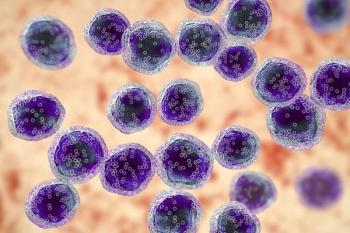
- Oncology Vol 28 No 12
- Volume 28
- Issue 12
Advanced DLBCL: As Systemic Therapy Improves, the Need for RT Diminishes
The major value of RT is in enhancement of local control. In localized disease, perhaps this is best achieved by using RT for patients treated with less than full-dose/course chemotherapy.
The review in this issue of ONCOLOGY by Dr. Boyle and colleagues from the Duke University Medical Center documents the value of complementary radiation therapy (RT) for diffuse large B-cell lymphoma (DLBCL), in both localized and advanced disease.[1] The survey of the role of CHOP (cyclophosphamide, doxorubicin, vincristine, prednisone) in the treatment of DLBCL adds little to the main thrust.
The addition of rituximab to the CHOP regimen was the single most effective event in lymphoma therapy, increasing the efficacy of CHOP in the elderly and in other patients with DLBCL,[2-4] leading one center to speculate that 6 cycles of R-CHOP in localized disease may replace a regimen of 3 cycles of R-CHOP and RT, which has been used routinely since the late 1990s.[5] Acceptance of R-CHOP as the new standard of care was based on two phase II trials[6,7] and three randomized trials.[8-10] Interestingly, no direct survival advantage could be assessed from the addition of RT to sites at which patients achieved complete remission. There is ample evidence that outcomes for patients at sites not achieving complete remission with chemotherapy can be improved by subsequent RT in localized and advanced disease.
The introduction of positron emission tomography (PET) has further aided the assessment of complete or partial remission. This is most telling in the report from the British Columbia group, in a retrospective study of 262 patients with advanced-stage DLBCL; in this study, 60 of 82 post-therapy PET-positive patients were irradiated, usually to a single site, and achieved results comparable to those observed in the nonirradiated PET-negative patients.[11] It is noteworthy that in published series there is a relatively wide definition of bulky disease, varying from > 5 cm to > 10 cm.
Except for the report from the British Columbia group, it is important to bear in mind that a review of the literature, including the references submitted with this review, generally fails to show an overall survival (OS) advantage to RT following chemotherapy in patients presenting with localized[12,13] or advanced disease.[14-16] Most published reports are retrospective series or surveys of the Surveillance, Epidemiology, and End Results (SEER) database, while the two prospective randomized trials in limited disease showed no survival advantage.[17,18]
In a French randomized trial (by the Groupe d’Etude des Lymphomes de l’Adulte [GELA]), CHOP/RT in localized disease was inferior to the more intensive regimen, ACVBP (doxorubicin, cyclophosphamide, vindesine, bleomycin, prednisone).[19] In an open-label phase III trial of patients (18 to 59 years of age) with untreated DLBCL at all risk stages, 3-year OS was superior with ACVBP combined with rituximab, at 92%, compared with an OS rate of 84% for patients randomized to treatment with R-CHOP (hazard ratio = 0.44; P = .0071).[20] RT was not included. It is accepted that R-CHOP is not optimal therapy for all risk groups of DLBCL, and efforts continue to investigate other options that may improve patient outcomes. New regimens, such as dose-adjusted EPOCH-R (etoposide, prednisone, vincristine, cyclophosphamide, doxorubicin, rituximab), have been shown to be extremely effective in patients with mediastinal large-cell lymphoma, achieving a 96% complete remission rate and a 5-year survival of 97%.[21] This regimen is being explored in DLBCL patients with high-risk stages, such as “double hit” variants-defined by a chromosomal breakpoint affecting MYC/8q24 in combination with another recurrent breakpoint, generally a t(14;18)(q32;q21) involving BCL2-and Burkitt-like presentations. A similar group of DLBCL patients designated as high-risk (ie, with at least one unfavorable factor, nongerminal center subtype, Ki-67 > 80%, high International Prognostic Index, and c-myc rearrangement) are being treated with R-HCVAD/R-MTX-Ara-C (rituximab, fractionated cyclophosphamide, vincristine, doxorubicin, dexamethasone alternating with methotrexate, cytarabine, rituximab). Retrospective analysis found 3-year progression-free survival was 79% and OS was 76% with this regimen, outcomes comparable to those achieved with R-CHOP in similar patient presentations.[22]
As new targeted agents emerge, such as the Bruton kinase inhibitor ibrutinib and the BCL-2 inhibitor ABT-199, they likely will be incorporated with active treatment regimens for DLBCL, in clinical trials. We can conclude that the major value of RT is in enhancement of local control. In localized disease, perhaps this is best achieved by using RT for patients treated with less than full-dose/course chemotherapy. In advanced disease, following successful primary systemic therapy, patients may benefit from selective RT treatment of residual isolated PET-positive sites. As the effectiveness of systemic therapy improves, the need for RT diminishes.
Financial Disclosure:The author has no significant financial interest or other relationship with the manufacturers of any products or providers of any service mentioned in this article.
References:
1. Boyle J, Beaven AW, Diehl LF, et al. Improving outcomes in advanced diffuse large B-cell lymphoma: systemic approaches and radiotherapy. Oncology (Williston Park). 2014;28:1074-84.
2. Coiffier B, Lepage E, Briere J, et al. CHOP chemotherapy plus rituximab compared with CHOP alone in elderly patients with diffuse large-B-cell lymphoma. N Engl J Med. 2002;346:235-42.
3. Sehn LH, Donaldson J, Chhanabhai M, et al. Introduction of combined CHOP plus rituximab therapy dramatically improved outcome of diffuse large B-cell lymphoma in British Columbia. J Clin Oncol. 2005;23:5027-33.
4. Coiffier B, Thieblemont C, Van Den Neste E, et al. Long-term outcome of patients in the LNH-98.5 trial, the first randomized study comparing rituximab-CHOP to standard CHOP chemotherapy in DLBCL patients: a study by the Groupe d’Etudes des Lymphomes de l’Adulte. Blood. 2010;116:2040-5.
5. Tomita N, Takasaki H, Miyashita K, et al. R-CHOP therapy alone in limited stage diffuse large B-cell lymphoma. Br J Haematol. 2013;161:383-8.
6. Tondini C, Zanini M, Lombardi F, et al. Combined modality treatment with primary CHOP chemotherapy followed by locoregional irradiation in stage I or II histologically aggressive non-Hodgkin’s lymphomas. J Clin Oncol. 1993;11:720-5.
7. Shenkier TN, Voss N, Fairey R, et al. Brief chemotherapy and involved-region irradiation for limited-stage diffuse large-cell lymphoma: an 18-year experience from the British Columbia Cancer Agency. J Clin Oncol. 2002;20:197-204.
8. Yahalom J, Varsos G, Fuks Z, et al. Adjuvant cyclophosphamide, doxorubicin, vincristine, and prednisone chemotherapy after radiation therapy in stage I low-grade and intermediate-grade non-Hodgkin lymphoma. Results of a prospective randomized study. Cancer. 1993;71:2342-50.
9. Miller TP, Dahlberg S, Cassady JR, et al. Chemotherapy alone compared with chemotherapy plus radiotherapy for localized intermediate- and high-grade non-Hodgkin’s lymphoma. N Engl J Med. 1998;339:21-6.
10. Horning SJ, Weller E, Kim K, et al. Chemotherapy with or without radiotherapy in limited-stage diffuse aggressive non-Hodgkin’s lymphoma: Eastern Cooperative Oncology Group study 1484. J Clin Oncol. 2004;22:3032-8.
11. Sehn LH, Klasa R, Shenkier T, et al. Long-term experience with PET-guided consolidative radiation therapy in patients with advanced-stage diffuse large B-cell lymphoma (DLBCL) treated with R-CHOP. Hematol Oncol. 2013;31(Suppl 1):137.
12. Martinelli G, Gigli F, Calabrese L, et al. Early stage gastric diffuse large B-cell lymphomas: results of a randomized trial comparing chemotherapy alone versus chemotherapy + involved field radiotherapy. Leuk Lymphoma. 2009;50:925-31.
13. Bonnet C, Fillet G, Mounier N, et al; Groupe d’Etude des Lymphomes de l’Adulte. CHOP alone compared with CHOP plus radiotherapy for localized aggressive lymphoma in elderly patients: a study by the Groupe d’Etude des Lymphomes de l’Adulte. J Clin Oncol. 2007;25:787-92.
14. Dorth JA, Prosnitz LR, Broadwater G, et al. Impact of consolidation radiation therapy in stage III-IV diffuse large B-cell lymphoma with negative post-chemotherapy radiologic imaging. Int J Radiat Oncol Biol Phys. 2012;84:762-7.
15. Held G, Murawski N, Ziepert M, et al. Role of radiotherapy to bulky disease in elderly patients with aggressive B-cell lymphoma. J Clin Oncol. 2014;32:1112-8.
16. Schlembach PJ, Wilder RB, Tucker SL, et al. Impact of involved field radiotherapy after CHOP-based chemotherapy on stage III-IV, intermediate grade and large-cell immunoblastic lymphomas. Int J Radiat Oncol Biol Phys. 2000;48:1107-10.
17. Phan J, Mazloom A, Medeiros LJ, et al. Benefit of consolidative radiation therapy in patients with diffuse large B-cell lymphoma treated with R-CHOP chemotherapy. J Clin Oncol. 2010;28:4170-6.
18. Ballonoff A, Rusthoven KE, Schwer A, et al. Outcomes and effect of radiotherapy in patients with stage I or II diffuse large B-cell lymphoma: a surveillance, epidemiology, and end results analysis. Int J Radiat Oncol Biol Phys. 2008;72:1465-71.
19. Reyes F, Lepage E, Ganem G, et al; Groupe d’Etude des Lymphomes de l’Adulte (GELA). ACVBP versus CHOP plus radiotherapy for localized aggressive lymphoma. N Engl J Med. 2005;352:1197-205.
20. Récher C, Coiffier B, Haioun C, et al; Groupe d’Etude des Lymphomes de l’Adulte. Intensified chemotherapy with ACVBP plus rituximab versus standard CHOP plus rituximab for the treatment of diffuse large B-cell lymphoma (LNH03-2B): an open-label randomised phase 3 trial. Lancet. 2011;378:1858-67.
21. Dunleavy K, Pittaluga S, Maeda LS, et al. Dose-adjusted EPOCH-rituximab therapy in primary mediastinal B-cell lymphoma. N Engl J Med. 2013;368:1408-16.
22. Mato A, Feldman T, Zielonka T, et al. Rituximab, cyclophosphamide-fractionated, vincristine, doxorubicin and dexamethasone alternating with rituximab, methotrexate and cytarabine overcomes risk features associated with inferior outcomes in treatment of newly diagnosed, high-risk diffuse large B-cell lymphoma. Leuk Lymphoma. 2013;54:2606-12.
Articles in this issue
almost 11 years ago
Chemotherapy for Low-Grade Gliomas: Lessons and Questionsalmost 11 years ago
Chemotherapy for Treatment of Grade II Gliomasalmost 11 years ago
Tailoring Chemotherapy for Low-Grade Gliomasalmost 11 years ago
What We Can Learn From Our Patientsalmost 11 years ago
Improving Outcomes in Advanced DLBCL: Systemic Approaches and Radiotherapyalmost 11 years ago
Who Should-or Should Not-Receive RT for DLBCL?almost 11 years ago
Grade II Gliomas-Not So Low Gradealmost 11 years ago
Cancer Stem Cells: Implications for Cancer Therapyalmost 11 years ago
Cancer Stem CellsNewsletter
Stay up to date on recent advances in the multidisciplinary approach to cancer.



















































































